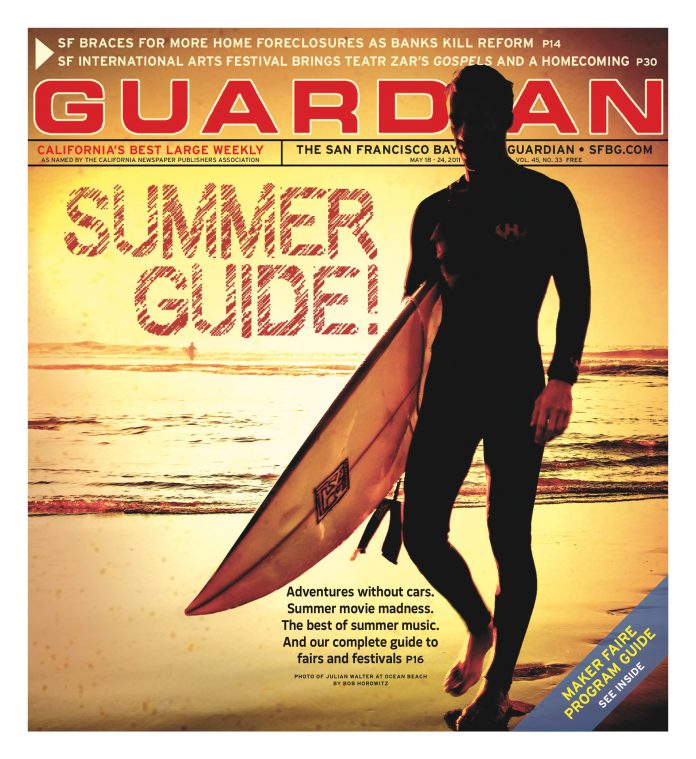“Surface, surface, surface.” Patrick Bateman’ pithy summation of the dominant aesthetic of his times in American Psycho could easily serve as a subtitle for Takeshi Murata’s colorful still lifes currently hanging at Ratio 3 (Murata’s computer animated short, I, Popeye, which plays in the gallery’s backroom, merits less discussion despite its gallows humor).
Seemingly random groups of objects — fruit, knickknacks, VHS cassette tapes of cult films such as Dario Argento’s Opera or Dawn of the Dead, a cow skull, cans of Coors, and what appear to be forlorn, soft-sculpture likenesses of brass instruments and a tea kettle — are arranged against neutral backgrounds and dramatically lit from a variety of angles.
Murata’s images are large and crisp. Their flawless, hermetically sealed perfection recalls certain advertising photography from (to return to American Psycho) the 1980s. Or, to go back a few years earlier, some of the album art created by British design firm Hipgnosis. The catch is that these images aren’t actually photographs of anything; they aren’t even photographs. Murata created these pigment prints — to call them by their proper name — with a computer, individually rendering each object, light source, shadow, and reflection.
The fact that there’s no there there shouldn’t be alarming. Open any lifestyle magazine and you’ll find countless examples of pictorial illusion promising the world. Murata’s images replicate the logic behind the shell game that advertising firms call doing business and Marxists call commodity fetishism. None of the objects in his compositions really make sense together syntactically, but bathed in the glow of a nonexistent photo studio each thing appears as strangely covetable as it does out of place.
This is not say that Murata’s compositions can’t simply be enjoyed for their pleasing arrangements of shape and color, or for the ways the objects play off each other (in Art and the Future, a replica of the Terminator’s chrome skull is paired with a copy of Douglas Davis’ 1975 treatise of the same name). Rather, these carefully orchestrated moments out of time complicate that enjoyment, asking us to reconsider the pleasures we take in looking at and staging displays of taste.
TAKE ME TO THE FAIR
Starting tomorrow through the rest of the weekend, San Francisco will become home to not one, not two, but three — count ’em, three — art fairs. The largest is the San Francisco Fine Art Fair, which returns to Fort Mason’s cavernous Festival Pavilion after its inaugural run last year. Then there are the two newcomers: ArtMRKT San Francisco at the Concourse Exhibition Center, the first Bay Area event put on by the Brooklyn-based art fair organizers of the same name, and the smaller scale, locally-based ArtPad SF, which takes over the rooms, patio, and even the pool of the Phoenix Hotel.
Art fairs are many things: commercial ventures, networking hubs, forums for and targets of critique, and socio-aesthetic petri dishes in which artists, dealers, gallerists, curators, critics, collectors, and gawkers all rub shoulders and share drinks. This kind of close proximity can be rare in San Francisco, which given its size, has a lot of different places to see art and a lot of different kinds of art to see. Sure, individual openings are their own kind of mixers, but not on the scale or with as diverse an audience as an art fair.
Almost every local gallery worth its salt, along with plenty of out-of-town exhibitors, will have a presence at one of the fairs (and to make taking it all in that much easier ArtMRKT and ArtPadSF will be sharing a shuttle service between venues on Saturday and Sunday). ArtMRKT and ArtPad SF, in particular, have also made it a point to involve community arts orgs and nonprofits. Black Rock Arts Foundation is ArtPad SF’s opening night beneficiary and ArtMRKT is hosting MRKTworks, an online and live auction set to benefit several other local arts nonprofits. ArtPAD SF will also host panel discussions on California art and collecting street art with a who’s who of notable locals and feature live performances and video pieces throughout the weekend.
What this confluence of big events means for the state of art-making and consuming in San Francisco remains up for discussion. Art fairs are one indicator of market growth — or at least of the organizer’s belief in a market’s potential, which in San Francisco’s case would mean having to address the fact that local artists have historically outnumbered local collectors. The proof, I suppose, will be in the attendance records and sales figures.
On the other hand, you can view these fairs as a sign of evolutionary development within the larger ecosystem of San Francisco’s art scene. Before last year’s SF Fine Art Fair, there hadn’t been a comparable event in the city for close to two decades. Maybe these are the sort of events SF needs to slough off of the self-deprecatory framework that regards what is made and what goes on here as “provincial” compared to Los Angeles or New York City. After all, “boosterism” needn’t be a dirty word.
I hope to expand on these issues in the next Eyeball, after I’ve had a chance to make the rounds and cool my feet in the Phoenix’s pool.
TAKESHI MURATA: GET YOUR ASS TO MARS
Through June 11; free
Ratio 3
1447 Stevenson
(415) 821-3371
ARTMRKT SAN FRANCISCO
Thurs/19– Sun/22; $25 (single day), $45 (3-day)
Concourse Exhibition Center
620 Seventh St., SF
(212) 518-6912
ARTPAD SF
May 19–May 22
Phoenix Hotel; $10
601 Eddy, SF
(415) 364-5465
SAN FRANCISCO FINE ART FAIR
May 20 –22; $20 (single day), $30 (3-day)
Festival Pavilion
Fort Mason Center, SF
(800) 211-0640

